Cotoneaster (Cotoneaster) belongs to the pink family, and is represented by deciduous and evergreen slow-growing shrubs or small trees. This plant was named by the Swiss K. Baugin, who was a botanist, he made the name from two Greek words "cotonea" - "quince" and "aster" - "having a similar appearance." The plant got this name due to the fact that one type of cotoneaster has leaf plates that are very similar to quince foliage. This genus unites more than 100 species, varieties and varieties. Such plants are found naturally in Eurasia and North Africa. Inexperienced gardeners think that cotoneaster and dogwood are the same plant. And in the end they plant a cotoneaster for the sake of tasty fruits, but they will not wait for them from it. These plants are only slightly similar in names, but otherwise they are completely different, and even belong to different families. In a cotoneaster, the fruits are outwardly similar to a small apple, and they are simply impossible to eat. The cornelian cherry fruits are juicy and tasty. The cotoneaster is valuable because it has a very beautiful appearance, and therefore can become a worthy decoration of any garden.
Content
- 1 Features of the cotoneaster
- 2 Planting a cotoneaster
- 3 Caring for the cotoneaster
- 4 Reproduction of cotoneaster
- 5 Cotoneaster in winter
- 6 Types and varieties of cotoneaster with photos and names
- 6.1 Brilliant cotoneaster (Cotoneaster lucidus)
- 6.2 Black cotoneaster (Cotoneaster melanocarpus)
- 6.3 All-edge cotoneaster, or ordinary cotoneaster (Cotoneaster integerrimus)
- 6.4 Cotoneaster horizontal (Cotoneaster horizontalis)
- 6.5 Dammer's cotoneaster (Cotoneaster dammeri)
- 6.6 Pressed cotoneaster (Cotoneaster adpressus)
Features of the cotoneaster
This shrub, depending on the species, can be either evergreen or deciduous. Most cotoneaster is a highly branched shrub that is often used for landscaping streets. In cities, you can often find a hedge made of such a plant. Small, simple alternate leaf plates are entire and ovoid. In summer they are dark green in color, and in autumn they change their color to various shades of red. Small flowers are colored white or pink. They can be solitary or be part of inflorescences that have the shape of a brush or shield. The fruits of the plant are small and have a black or red color. This very slow-growing shrub can be grown in the same place for about 50 years, and in some cases even longer.About 40 species of such a plant are cultivated, but in addition to them, many varieties and varieties of cotoneaster are also grown. The most popular are cotoneaster: whole-edged, shiny and black-fruited, which are highly frost-resistant. Amateur gardeners like this plant because it is undemanding to care for and unpretentious. Professional gardeners often use this shrub to create a hedge.
Planting a cotoneaster
What time to plant
Almost all types of such a plant are recommended to be planted in open soil in the spring. In this case, you need to wait until the earth warms up well, but the buds should not begin to open yet. Also, such a shrub can be planted in the autumn, while this should be done after a massive fall of leaves, but before frosts begin. In the fall, for example, it is recommended to plant the black and shiny cotoneaster. Such a plant can be safely grown in shaded areas, while it will look quite impressive. But if a shrub is planted in an open, well-lit area, then it can reach the peak of its decorative effect. What quality soil for a cotoneaster is not of particular importance. Experienced gardeners advise pouring a suitable soil mixture directly into the planting hole.
How to plant
The size of the planting hole for this plant should be 50x50x50 centimeters. A drainage layer with a height of 20 centimeters should be laid at the bottom, and for this it is recommended to use broken brick or gravel. On top of it, you need to fill it with an earth mixture consisting of sand, peat, humus and sod land, which must be taken in a ratio of 1: 1: 1: 2. If possible, it is recommended to pour from 200 to 300 grams of lime into the resulting soil mixture. When choosing a place for planting, it should be borne in mind that there should be a distance of 0.5 to 2 meters from the cotoneaster to a neighboring tree, shrub or structure. The final value of the distance in this case depends on the estimated size of the crown of an adult shrub. When planting a seedling, you should pay attention to the fact that its root collar should be at the same level with the soil surface. When planting is complete, the soil must be well compacted and the plant must be watered. When water is absorbed into the soil, the surface of the trunk circle is covered with an eight-centimeter layer of mulch (peat). If a hedge is created from a brilliant cotoneaster, then it is recommended to make trenches for planting instead of holes.
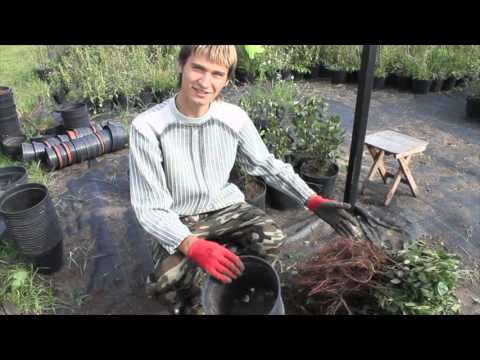

Watch this video on YouTube
Caring for the cotoneaster
There is nothing difficult in planting and growing a cotoneaster. At the same time, difficult situations when growing this shrub are extremely rare, and they can be easily resolved. The most important thing that every gardener needs to know is that such a plant reacts extremely negatively to stagnant fluid in the root system. The rest of the adverse natural phenomena do him practically no harm. Watering this plant is not needed at all, and even during a long dry and sultry period. If there is no rain for the entire summer period, then you will still have to water the cotoneaster, and this should be done once every half a month, while from 70 to 80 liters of water goes to 1 adult bush. After the rain has passed or watering has been carried out, it is necessary to weed the shrub and loosen the soil surface under it to a depth of 10 to 15 centimeters. It should be remembered that the leaves of the shrub must be systematically washed with a stream of water, especially if such a hedge from a shiny cotoneaster is used instead of a fence that overlooks a busy street.
Top dressing
After the first warm spring days come, it will be necessary to feed the shrub with nitrogen-containing fertilizers.To do this, you can use a urea solution (for 10 liters of water 25 grams of a substance) or granules of prolonged exposure to Kemira-universal. Before flowering, the plants must be fed with superphosphate (60 g per 1 m2) and potassium (15 g per 1 m2). When the season is over, the surface of the trunk circle will need to be covered with a layer of mulch (peat).
Cotoneaster pruning
Such a plant is extremely positive about pruning. Experienced gardeners and designers create a variety of shapes from bushes, for example, prisms, cones, hemispheres, etc. It should be remembered that the annual stem can only be cut by 1/3 of the growth. Curly pruning of a cotoneaster will require not only special tools, but also some experience and knowledge. The shoots growing after pruning are capable of maintaining the shape given to them. Pruning of such a shrub is also carried out for sanitary purposes, while it is necessary to cut off those branches that are injured, old, affected by the disease, or that contribute to the thickening of the crown. Over the years, it becomes necessary to carry out anti-aging pruning. A sanitary haircut can be done in any of the months. At the same time, pruning in order to form the crown or rejuvenate the bush should be carried out in early spring, while the buds have not yet begun to open.
Diseases and pests
This plant is highly resistant to diseases and pests. However, quite rarely, apple aphids can settle on the lower surface of the leaves. In infected specimens, the leaf plates become wrinkled, and the stems become curved and dry. Also, scale insects or ticks can settle on the cotoneaster. To get rid of such pests, you can use decoctions made from tobacco, makhorka or yarrow. You can also use more potent insecticides. Cotoneaster more often than other diseases suffer from fusarium. To cure a shrub, it is necessary to cut out the affected parts of the plant to healthy tissue, and then treat it with a fungicidal agent.
Reproduction of cotoneaster
Different types of such a plant can be propagated in different ways. Those who want to grow this shrub from seeds should take into account that its seeds have an extremely low germination capacity, in this regard, they should be sown with a margin. Sowing is carried out directly into the open ground before winter. Before the onset of spring, the seeds will be able to undergo natural stratification in the soil. Seedlings should appear with the onset of spring. This plant can be propagated by cuttings, dividing the bush and layering.
How to grow from seeds
First you need to collect the fruits of the plant and wait until they fall a little, in this case, the pulp can be quite simply separated from the stone. The extracted seeds should be thoroughly rinsed in clean water. Then they are placed in a glass jar filled with water. Those seeds that remain floating on the surface can be safely thrown away. For sowing, use those that have sunk to the bottom of the container. Then the seeds must be combined with peat and sand, and the resulting mixture is placed in boxes. Further, the boxes are put away for storage until the onset of the spring period in a place where the air temperature will keep about 0 degrees. Thus, the seeds will be able to undergo stratification and will need to be planted in open soil in the spring. But it should be borne in mind that even correctly carried out stratification is not a guarantee that the seeds will sprout.
Cuttings
When the shining cotoneaster bush is pruned, there will be many cuttings that can be rooted. However, the most suitable time for cutting cuttings is June. Slices of prepared cuttings must be immersed for 24 hours in a container filled with a solution of a product that stimulates root formation. Then they should be planted on a prepared bed at an angle of 45 degrees. The soil should be loose and light, and consist of peat and sand.Then you should water the cuttings with lukewarm water, and cover them with a large plastic bottle, from which you should first cut off the neck. On a sultry day, the cotoneaster can begin to rot, and in order to prevent this from happening, the shelter should be removed for a day. Watering can be done without removing the shelter. By the next spring period, the cuttings will give roots, and they can be planted in a permanent place.
How to propagate by layering
This breeding method is often used for ground cover species, for example, horizontal or creeping cotoneaster. In these species, the stems are in close proximity to the surface of the soil or touch it. Select young stems and fix them to the soil surface with a hook or metal staple. Then the attachment point must be sprinkled using humus for this. With the onset of the next spring period, the rooted cuttings can be separated from the parent bush and transplanted to a permanent place. This breeding method is the simplest and most effective.
How to propagate by dividing a bush
Adult, heavily overgrown bushes can be divided into several parts. The resulting cuttings can be rooted. This method is distinguished by its speed and high efficiency. It is possible to divide the bush in spring or autumn, while the divisions must be immediately planted in a permanent place.
Cotoneaster in winter
Fall
Almost all types of cotoneaster are distinguished by their frost resistance and can easily survive the winter without insulation. However, the trunk circle must be sprinkled with a layer of mulch (peat). In the event that there is a threat of freezing of the cotoneaster, then it is recommended to bend it to the soil surface and fix it in this position. Then the bush must be covered with dried leaves.
Wintering
If a winter period with little snow or too frosty is expected, then the bush can be additionally insulated with a covering material or spruce branches. If a large amount of snow falls, then it is recommended to remove the shelter. The bushes will need to be covered with a layer of snow. In the middle lane, the most popular cotoneaster is whole-edged, black-fruited and shiny. These species are very winter hardy and can withstand severe frosts without insulation.
Types and varieties of cotoneaster with photos and names
The types of cotoneaster that are most popular with gardeners will be described below.
Brilliant cotoneaster (Cotoneaster lucidus)
His homeland is Eastern Siberia. This shrub can grow in nature both in groups and singly. This deciduous shrub has dense foliage and is upright. In height, such a plant can reach 200 centimeters. On the surface of young shoots there is dense pubescence. The length of the dark green glossy leaf plates is about 5 centimeters, while they have an elliptical shape and are pointed towards the apex. Loose inflorescences in the form of a shield consist of pink flowers. Flowering begins in May or June and lasts 4 weeks. After flowering, glossy black spherical fruits appear, which do not fall off until the onset of the winter period. The bush begins to bear fruit at the age of four. This type is used in order to create a hedge or to decorate the lawn and the edge. It has been cultivated since the beginning of the 19th century.
Black cotoneaster (Cotoneaster melanocarpus)
Suitable for growing in mid-latitudes, as it has sufficient winter hardiness. In such a cotoneaster, unlike many other species, the fruits can be eaten. Under natural conditions, this shrub is found in Central Asia, Central Europe, the Caucasus and Northern China. The height of the bush can reach 200 centimeters. On brown-red stems, there are black fruits. The length of the ovoid leaf plates is about 4.5 centimeters, while the front side is dark green, and the back side is white-felt. The apex of the leaves is obtuse or notched.The plant begins to bear fruit every year from the age of five. Loose racemose inflorescences consist of 5-12 pink flowers. Flowering lasts about 25 days. This type is frost and drought resistant. And also this excellent melliferous plant has wood from which pipes, canes, etc. are made. There is a decorative form of laxiflora. It is distinguished by loose drooping inflorescences and larger fruits than the original species. Cultivated since 1829
All-edge cotoneaster, or ordinary cotoneaster (Cotoneaster integerrimus)
This deciduous shrub can be found in natural conditions from the North Caucasus to the Baltic on mountain slopes, in sandstones and limestones. Such a plant is rarely cultivated. The bush can reach a height of 200 centimeters. Has a rounded crown. On the surface of young branched stems there is woolly pubescence. However, over time, they become bare. The length of the broadly ovate leaf plates is about 5 centimeters. The front side is smooth, glossy, dark green, and the back side is gray-felt. The racemose inflorescences consist of 2-4 whitish-pink flowers. The diameter of the deep red fruit is approximately 10 mm. Such a plant is highly resistant to frost, drought and gas. Cultivated since 1656
Cotoneaster horizontal (Cotoneaster horizontalis)
This shrub is related to the common species. The height of such an evergreen plant is about 100 centimeters, while its crown in width can reach 150-200 centimeters. The stems are arranged in layers, like the backbone of a fish. Glossy green leaf plates, which have a rounded shape, change their color to fiery red in autumn. Small whitish pink flowers open in the last days of May. Flowering lasts about 20 days. A lot of scarlet fruits appear on the bush, which will fully ripen in September. In some cases, they do not fall until the next spring. This type has special requirements for the quality and composition of the soil. Cultivated since 1880. There are a couple of varieties:
- Variegatus. It reaches a height of 0.3 m, while the crown diameter is about 150 centimeters. The sheet plates have a white strip along the edge.
- Perpusillis. The height of the open bush reaches 0.2 meters, while in diameter it can reach 1 meter. Slow growing. Pink flowers bloom at the beginning of summer. Ripening of scarlet fruits occurs in the last days of summer. Green leaf plates in autumn change their color to burgundy.
Dammer's cotoneaster (Cotoneaster dammeri)
This shrub looks very similar to the horizontal cotoneaster. Under natural conditions, it can be found in the mountains of Central China. The creeping stems are practically in contact with the surface of the soil, in this regard, their independent rooting often occurs. Stems branch in one plane, while they rise by no more than 20-30 centimeters. At the same time, they can grow up to 150 centimeters wide. Small leathery leaf plates are elliptical in shape. They are dark green in summer and purple in autumn. Sessile flowers are light red. Ripening of red-coral berries occurs in September, while they stay on the bush for a long time. Cultivated since 1900 Popular varieties:
- Eichols. It reaches 0.6 m in height and has orange-red berries.
- Coral Beauty. The height of the bush is about 0.4 m. Large single berries are colored red. This plant is distinguished by the highest frost resistance of all varieties that are available in this form.
- Stockholm. The height of the bush is about 100 centimeters. The color of the berries is deep red.
Pressed cotoneaster (Cotoneaster adpressus)
This shrub is a dwarf creeping shrub. It reaches a height of about 50 centimeters, and its diameter is about 100 centimeters. The stems are pressed to the ground surface. Small leaf plates are rounded.In summer, they are pale green, and in autumn, they are deep or dark red. In the last days of spring, a large number of pink flowers open. Such a plant must be covered for the winter.
Gardeners also grow cotoneaster: spread out, Mupinsky, holly, small-leaved, multi-flowered, pink, one-flowered, Henry, bubbly, Franchet, brush-colored.

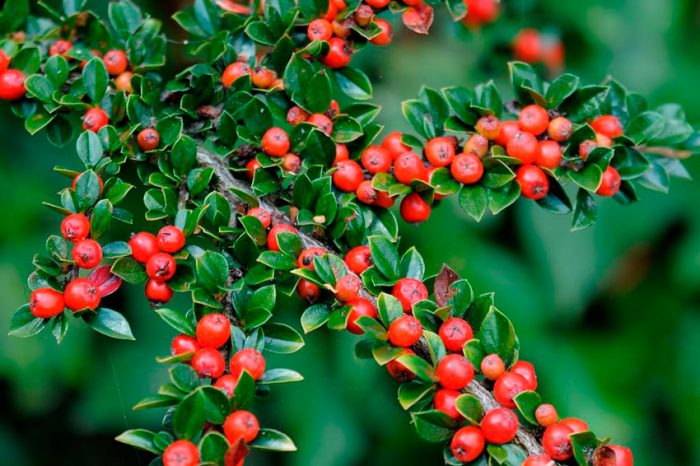
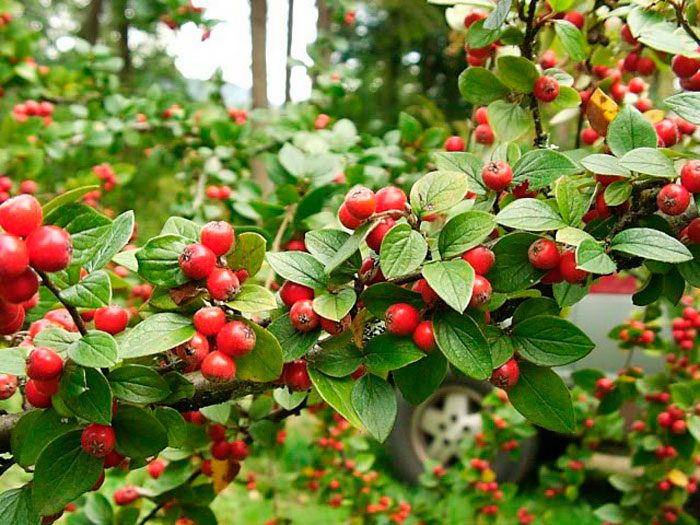

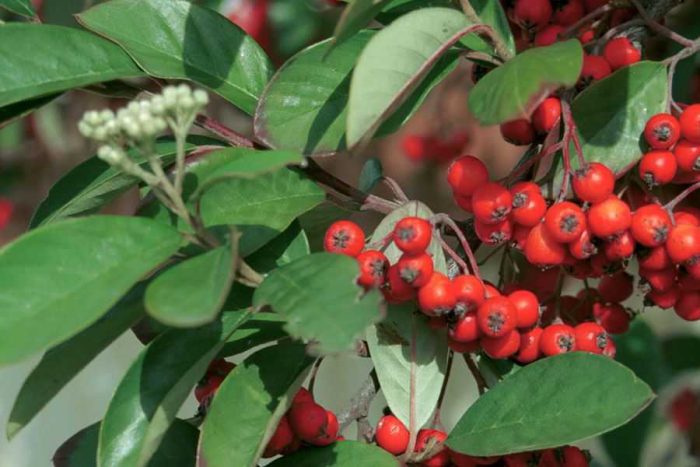
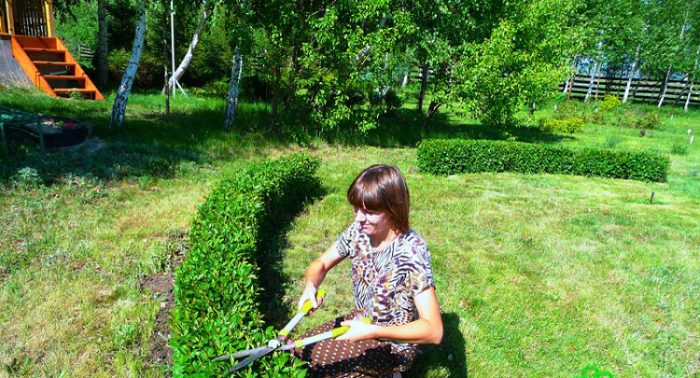
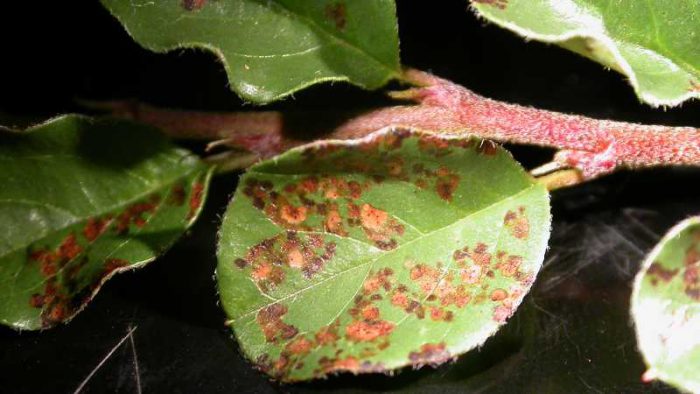
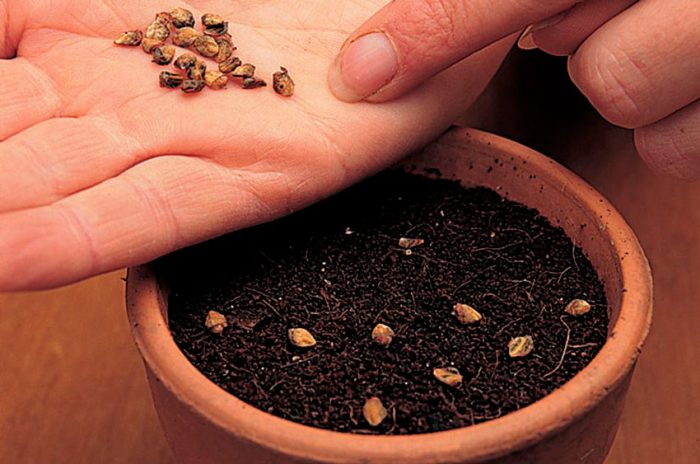
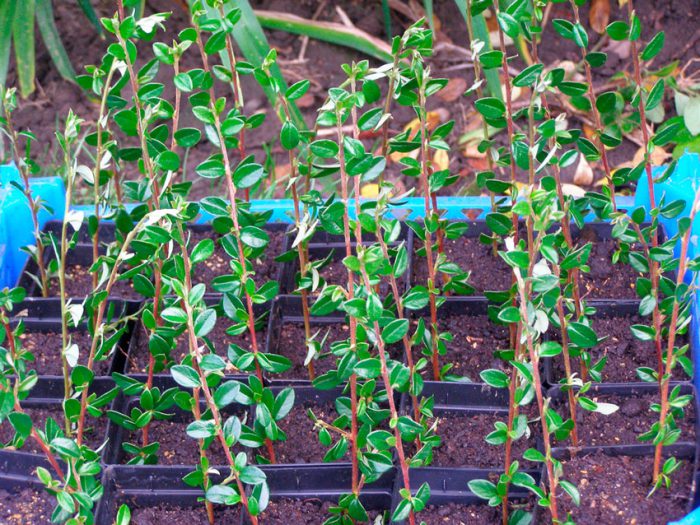

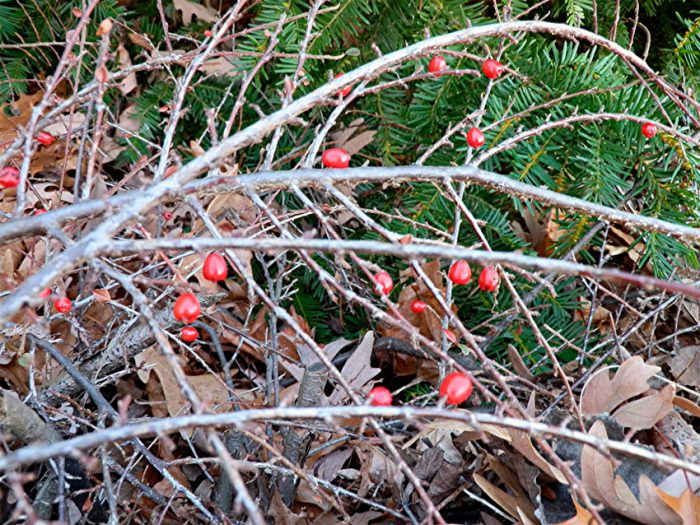
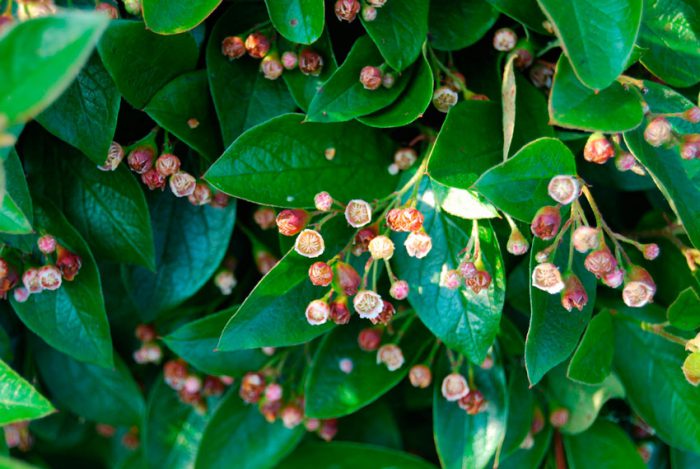

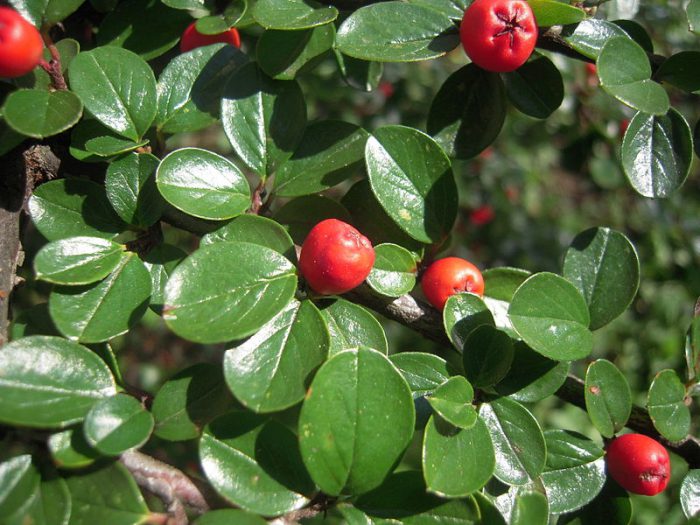
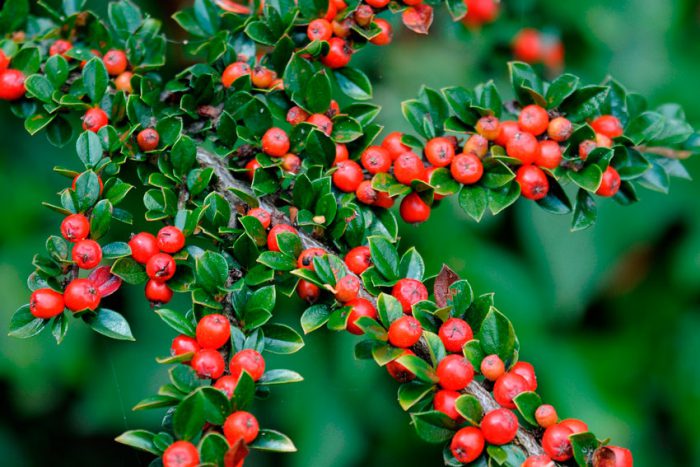
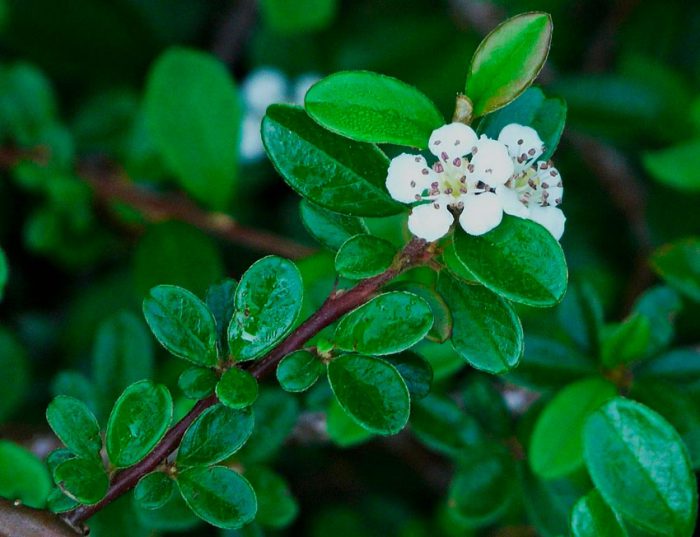
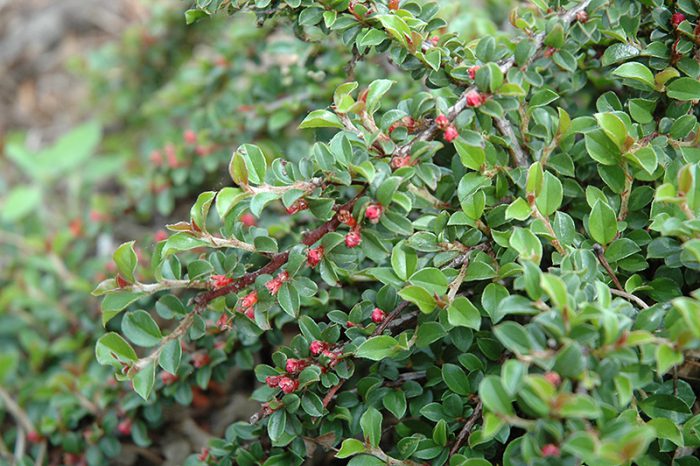








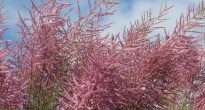

I cannot say for all types of cotoneaster, I have not even come across them, but an ordinary cotoneaster is really very beautiful. We don't have a solid fence at the dacha, so as long as I watch, not a single person passed by so as not to admire.